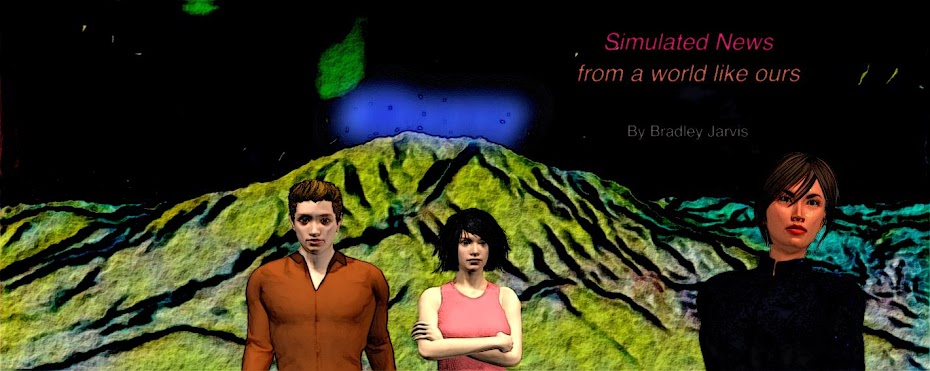After a week of planting native trees with me and Al as part of the new region-wide Restoration program, Maura awoke from a dream of a day in a world where such a program and the strategy that inspired it were never considered more than a dream themselves.
As “Mari,” she worked as a low-level financial analyst at a defense company that had no interest in developing truly life-saving technologies. The day began with a casual breakfast in front of her television, swearing at news reports of a self-destructing federal government led by isolationists who were focused on accumulating as much personal power as possible for themselves and their supporters. Her live-in fiancé John, an electronics store technician she met in a previous job, reminded her that the current focus on weapons development and profit-boosting deregulation meant they had a better chance of paying off her recent medical bills and moving from their tiny apartment into a real house just in time for their wedding at the end of the year.
Mari’s commute was excruciatingly long and perilous, spent mostly in start-and-stop traffic undeterred by automated signs requesting that people not drive due to elevated ozone levels exacerbated by vehicle exhaust. Bored by the music choices on the radio, she gambled on listening to more news, and almost caused a crash when a reporter announced that a deep recession might be imminent if not already in progress. She had a flash of a global trend analysis that Maura had done months ago, which anticipated just such a possibility in this timeframe as a precursor of a world population peak five years in the future. The implication of the report sent a shock through her mind; if it turned out to be true, then the peak might be too, along with the rapid fall toward extinction that followed.
She took a deep breath as she listened to the much more benign explanations being offered by economists: that the government’s corruption had critically reduced market confidence in it exercising rational economic policy; that recent GDP fluctuations indicated a reset was due following the last twelve years of growth; and that automation and other technologies were reshaping the workplace faster than expected. All of them would have been enough for the original Mari, but as Mari/Maura she knew there were much larger forces in play that demanded an understanding that encompassed more than strictly political and economic considerations.
By the time she arrived at work, the company’s Chief Financial Officer had already directed analysts in her office and elsewhere to run reality checks on the recession fears, develop likely scenarios, and recommend strategies for minimizing exposure to losses that might result. Technically, Mari’s role was to error-check the scenarios and strategies that the experts produced, but she felt compelled to share her concerns with them directly at the earliest stage. The dream ended following a particularly uncomfortable meeting with them.
“They acted like she was crazy,” Maura told me near the end of her narrative, “dismissing it as a dystopian fantasy that no rational person would subscribe to. It reminds me of the debate when WICO proposed the biosphere assessment. At least we finally agreed to replace opinion with facts, and accept all their implications. These people were limiting the scope of the ‘reality’ they considered, based on their own opinions, and blaming her for questioning it.”
I decided to play the devil’s advocate. “To be fair, she couldn’t divulge the source of her concern, what you learned, mainly because they reasonably wouldn’t believe it coming from her.”
“They had more than enough information already. Their scientists and a lot of activists were already sounding the alarm over several aspects of the extinction threat. The United Nations, their version of WICO, was even getting nations to enter treaties to deal with it. Private industry was pushing what they called renewable technology, an ill-conceived attempt to continue the status quo without a very limited set of environmental costs. Unfortunately, they failed to consider a lot of the critical costs.”
“You learned all that in a dream?” I asked.
“You can learn a lot when you share someone’s mind.”
“Which outside of a dream would sound crazy, right?”
“Right,” she admitted. “Some of the simulations I did when I was at WICO were turned into a story by my subconscious. I’m sure that with some research I could identify which ones they were, which makes the story worth telling.”
Reality Check
Mari’s world is based on the simulation Hella, whose history and future starting in 2015 matches simulation Green - what I judge to be the best match to our real world. In the fictional backstory (explored in Will Jackson’s Personal Log), Maura has a limited ability to observe and interact with versions of herself in the “worlds” of other simulations (as they can with her) - providing a means of comparing relevant parts of the simulations in any given story.
In Hella, global variables change annually as follows:
In all three simulations, self-sustaining impacts reduce total resources after 2014, but of course Hikeyay (Maura’s world) is intentionally decreasing consumption as part of the global strategy.








